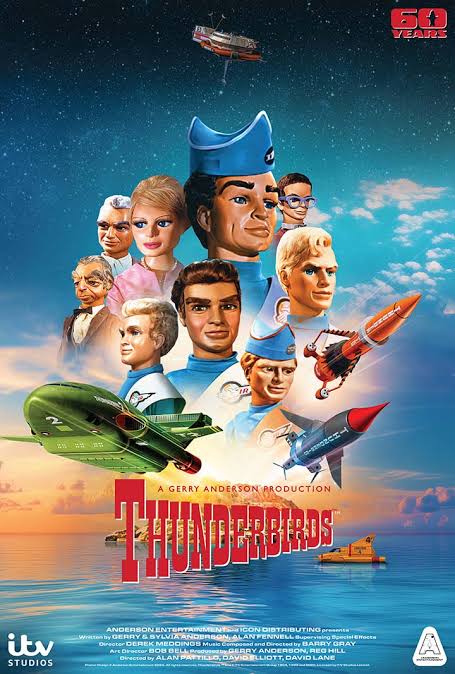Thunderbirds at 60: International Rescue Still Soars
Sixty years ago, a countdown changed television forever.
“Five… four… three… two… one… Thunderbirds are go!”
With that electrifying phrase, a new era of British science fiction launched from a modest studio on the Slough Trading Estate. The year was 1965, and Thunderbirds, created by the visionary team of Gerry and Sylvia Anderson, made its debut on ATV Midlands. No one could have predicted that a show featuring marionette puppets, model sets, and miniature explosions would become a global cultural phenomenon — but Thunderbirds did exactly that.
Six decades later, the spirit of International Rescue remains as thrilling as ever.
—
A Vision Beyond Its Time
Gerry and Sylvia Anderson had already found success with earlier “Supermarionation” series such as Stingray and Fireball XL5, but Thunderbirds was different — bigger, bolder, and far more ambitious. Its budget dwarfed anything previously attempted for British television. The Andersons wanted to bring Hollywood spectacle to the small screen, and they succeeded.
Each episode was a mini-movie. Explosions were choreographed like ballet, and the futuristic vehicles — the Thunderbirds craft — were engineering masterpieces in miniature form.
Thunderbird 1: the sleek hypersonic rocket, always first to the danger zone.
Thunderbird 2: the heavy-lifting transporter with its iconic green fuselage and modular pods.
Thunderbird 3: the red space rocket, symbolizing adventure beyond Earth.
Thunderbird 4: the yellow submersible ready to dive into the deep.
Thunderbird 5: the orbiting space station, listening for every distress call.
These machines weren’t just props — they were characters in their own right, symbols of hope and heroism.
—
The Tracy Family and International Rescue
At the heart of Thunderbirds were the Tracys — a family bound by courage, compassion, and duty. Led by ex-astronaut Jeff Tracy, the five brothers — Scott, Virgil, Alan, Gordon, and John — embodied the ideal of teamwork in the service of humanity.
Operating from their secret Tracy Island base, they raced around the world to save lives from disasters on land, sea, and sky. No mission was too dangerous, no challenge too great. Each rescue embodied the show’s core message: that advanced technology, guided by empathy, could make the world a better place.
The series struck a chord during the optimistic yet uncertain 1960s — the dawn of the space age. While nations looked to the stars, Thunderbirds reminded viewers that the true test of progress was how people used technology to help one another.
—
A Global Phenomenon
Though it began as a British show, Thunderbirds quickly became an international hit. It aired across Europe, Japan, and North America, capturing the imagination of audiences young and old. Its catchphrases entered popular culture, and the countdown became instantly recognizable.
The craftsmanship behind Thunderbirds was staggering. Derek Meddings’ special effects team pioneered miniature filmmaking techniques that would later influence Hollywood blockbusters — from Star Wars to Indiana Jones. Decades before CGI, Thunderbirds proved that creativity could outshine technology.
Even today, filmmakers like Peter Jackson and James Cameron cite the series as an inspiration. The blend of practical effects, emotional storytelling, and futuristic design created a legacy that continues to shape science fiction storytelling.
—
Reboots, Revivals, and an Enduring Legacy
The power of Thunderbirds never faded. Over the years, the series has been revived, reimagined, and celebrated in countless forms — from the 2004 live-action film to the acclaimed Thunderbirds Are Go! CGI reboot launched by ITV in 2015. Each generation finds new ways to rediscover the magic.
Yet, the original 32 episodes remain timeless. Their handcrafted models, vibrant colors, and bold music by Barry Gray still dazzle. The voice performances — including Shane Rimmer, David Graham, and Sylvia Anderson herself as Lady Penelope — bring warmth and wit that modern technology can’t replicate.
From toys and comics to museum exhibits and stage shows, Thunderbirds continues to inspire fans worldwide. In the age of AI, drones, and real-life space exploration, its vision of altruistic innovation feels more relevant than ever.
—
From Slough to the Stars
As Thunderbirds celebrates its 60th anniversary, its impact extends far beyond nostalgia. It stands as a symbol of British ingenuity, imagination, and optimism. The Andersons didn’t just create a TV show — they built a universe where kindness and courage always took flight.
From a small workshop in Slough to hearts around the world, Thunderbirds taught generations to believe in the power of teamwork and the thrill of doing good.
So, six decades on, as fans everywhere celebrate, one phrase still unites them —
“Five… four… three… two… one… Thunderbirds are go!”

